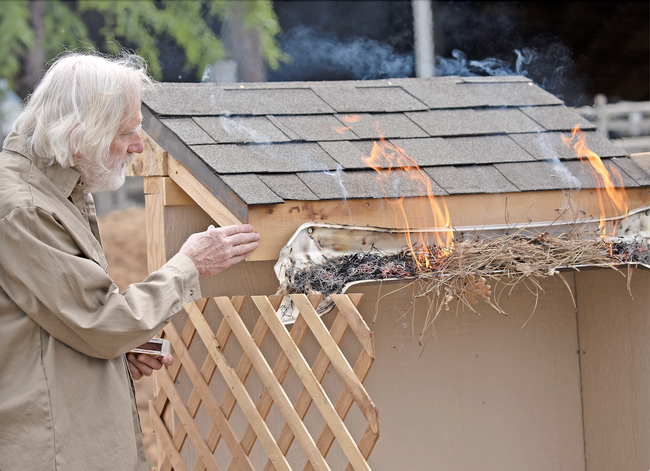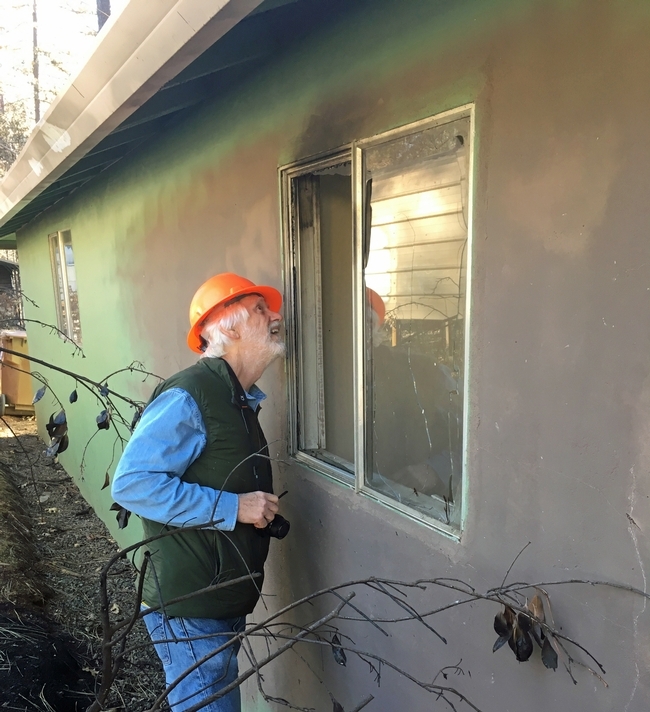Posts Tagged: environment
Blacklighting at the Bohart: They Saw the Light
They saw the light. The insects, that is. Bohart Museum of Entomology research associate John "Moth Man" De Benedictus and...

John "Moth Man" DeBenedictus, a research associate at the Bohart Museum of Entomology, showed part of his moth collection at the Bohart open house. (Photo by Kathy Keatley Garvey)

John "Moth Man" DeBenedictus, answers questions at the Bohart Museum of Entomology Moth Night. (Photo by Kathy Keatley Garvey)
Identify and Learn About the 73 Dragonfly Species (Anisoptera) in California
If you're like me, your heart skips a couple of beats when you encounter a dragonfly, especially the fire-engine red flameskimmer, Libellula...

Kathy Biggs (left) and Sandra von Arb are co-authors of the newly published "Dragonflies (Anisoptera) of California."

Dragonfly experts participating in a 2015 Bohart Museum of Entomology open house included (front, from left) Andrew Rehn of the California Department of Fish and Wildlife, Kathy Biggs, author of dragonfly books, and Sandra von Arb, then a senior biologist at the Pacific Northwestern Biological Resources, McKinleyville, Calif. In back are Rosser Garrison (left), now retired from the California Department of Food and Agriculture, and Bohart associate Greg Kareofelas.

A flameskimmer, Libellula saturata, in a Vacaville garden. (Photo by Kathy Keatley Garvey)
A Butterfly and a Bush: A Love-Hate Relationship
When a newly eclosed Western tiger swallowtail, Papilio rutulus, lands on a butterfly bush, the colors are striking. The yellow and black...

A Western tiger swallowtail, Papilio rutulus, nectaring on a butterfly bush, Buddleja davidii. (Photo by Kathy Keatley Garvey)
Report: Making homes more resistant to wildfire can be affordable
Priorities include removing objects within five feet of a house, upgrading vents
Wildfire losses cost taxpayers and communities hundreds of billions of dollars each year, and preparing communities before a disaster occurs is the best way to avoid damage to homes and neighborhoods. Retrofitting existing homes can make communities safer while avoiding billions in disaster costs.
As Californians learn to live with wildfire, scientists encourage improving the structure and design of houses and other buildings to help them survive wildfire. A new report shows that even inexpensive changes can increase wildfire resistance.
“Retrofitting a Home for Wildfire Resistance” suggests that some of the most effective strategies to reduce the vulnerability of homes and neighborhoods to wildfire can be done affordably.
“This report is a practical tool that helps evaluate the relative costs and benefits of fire-hardening retrofits,” said Yana Valachovic, a University of California Cooperative Extension forest advisor, who reviewed the study. “These retrofits can substantially improve the odds that a home or building will withstand wildfire exposures to embers, radiant heat or flame contact.”
The report is co-authored by Kimiko Barrett, wildfire research and policy analyst for Headwaters Economics, a non-partisan research organization based in Bozeman, Montana, and Stephen L. Quarles, UC Cooperative Extension advisor emeritus, who has studied the vulnerability of the built environment to wildfire exposures and potential mitigation strategies.
In partnership with California's Department of Forestry and Fire Protection, or CAL FIRE, Barrett and Quarles examined the costs for improving the structure and design of existing homes to increase their wildfire resistance.
“This tool can also help homeowners build a budget and prioritize tasks that often feel overwhelming,”Valachovic said. “Everyone should prioritize removing combustible vegetation, mulch, and stored materials within the first five feet of a structure and upgrading vents to resist embers.”
Simple actions can reduce a home's vulnerability to wildfire
The report's conclusions are derived from a detailed examination of the latest available science on mitigation strategies and construction costs. The authors identified costs for retrofitting structures to meet and exceed California's building code (Chapter 7A) for wildfire resistance, but the general principles and conclusions can be applied in other states, adjusting for local economic and supply conditions.
For a typical 2,000-square-foot home in California, retrofitting costs can range from $2,000 to upwards of $100,000 for the highest level of protection.
“When we looked at the latest building techniques and cost data, we found some effective retrofitting strategies can be done for between $2,000 to $10,000,” said Barrett. “While the highest level of protection can cost more, it is often not necessary. Simple actions such as removing flammable materials from near the home and removing debris from the roof can be done at little to no cost.”
The authors also incorporated effective mitigation strategies that could reduce risk without requiring costly upgrades over the entire home, such as replacing siding only on the side of a home that is close to another building, such as neighbor's home or a detached garage, or replacing combustible deck boards next to the home with a noncombustible deck board or metal grate.
They also incorporated a systems approach, where the vulnerability of adjacent components are considered, and recommend steps such as placing noncombustible surfaces at the intersection between two components.
For example, Quarles said: “Adding a gutter cover and ensuring the adjacent edge of roof is not vulnerable by incorporating a metal drip edge and, if necessary, a noncombustible bird stop at the edge of the roof. Or, replacing a combustible deck board next to the house and, if necessary, adding metal flashing at the base of the exterior wall.”
Cost estimates in the report include those for upgrading a home's exterior walls, roof, deck, windows, doors, eaves, gutters and near-home landscaping – all areas likely to be exposed to embers, direct flames and radiant heat.
“The graphics detailing specific elements of the retrofitting process are very useful,” Valachovic said.
Charts, architectural renderings and a detailed appendix of cost estimates provide a basis for a general understanding of the methods and budgets that homeowners might consider when retrofitting their home for wildfire resistance.
Retrofitting for wildfire can make communities safer
Contractors and others seeking information about building wildfire-resistant homes can gain valuable insights from this analysis, along with retrofit costs generated by the California Wildfire Mitigation Program.
“This analysis demonstrates that investing in wildfire-resistant retrofitting for homes is a cost-effective strategy to protect communities that could save billions in disaster costs,” said Barrett. “As more people live in fire-prone areas, we must also take a closer look at retrofitting homes to be stronger and more durable.”
While the authors hope Californians use the information to protect their homes, people who work in construction, development, design and policy also can use the information to show that retrofitting homes for wildfire resistance is an effective way to protect communities.
This 58-page report received funding from CAL FIRE and the U.S. Forest Service and can be downloaded for free at https://headwaterseconomics.org/wp-content/uploads/2024/06/Wildfire_Retrofit_Report_20240624.pdf.
Don't Miss Bohart Museum Open House on Moths!
You won't want to miss the Bohart Museum of Entomology Moth Night on Saturday, July 20. So much to see and do, and so many moth...

UC Davis doctoral student Peter Coggan (Photo by Kathy Keatley Garvey)

Peter Coggan of northern Minnesota is a moth'er and a member of the board of the Minnesota chapter of National Dark Skies. His son, Peter, also a moth'er, is a UC Davis doctoral student.




